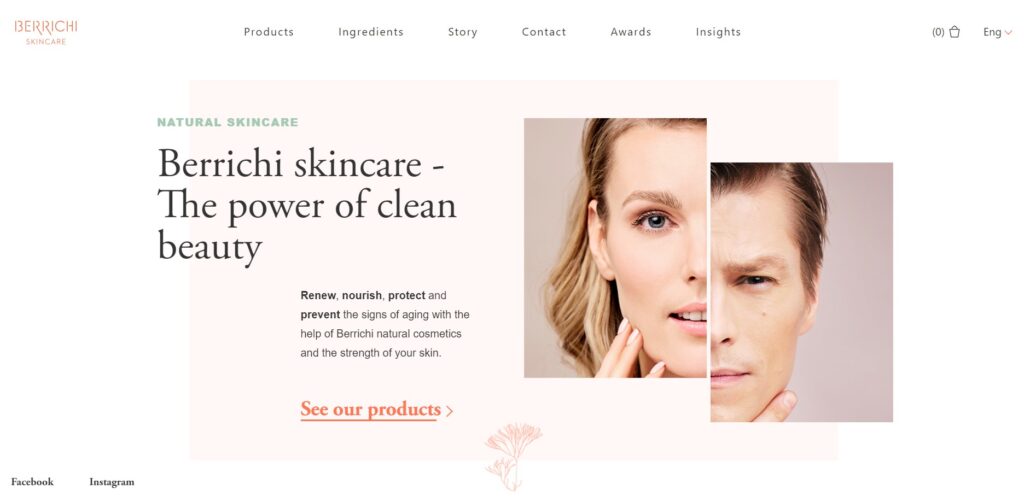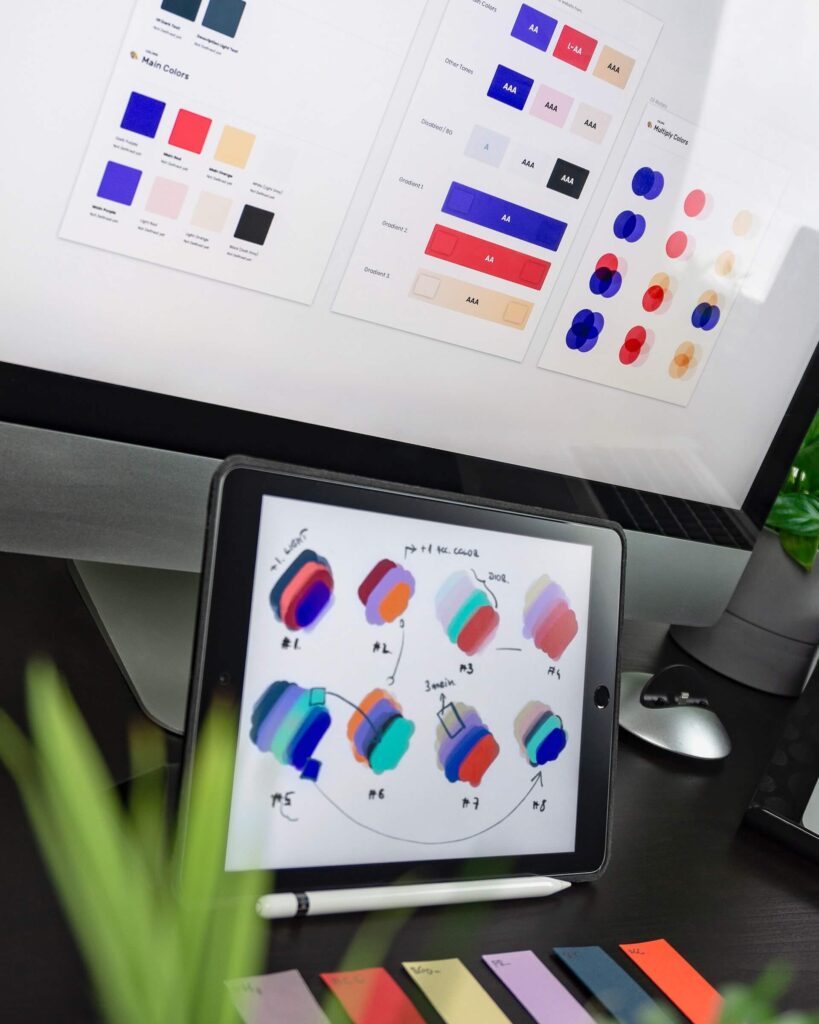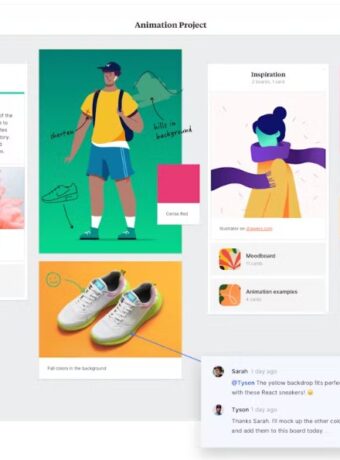What is Visual Branding and How It Can Help Your Business
Having a great product or service is not enough – you need solid visual branding to help you stand out from the crowd.

Visual brand identity includes design elements such as colors, materials, shapes, fonts (typography), and functionality.
While visual identity is not the same as branding, successful visual branding creates a memorable experience for the consumer that can help build brand awareness and loyalty. Let’s take a closer look at visual branding and how it can help your business.
What is visual branding?
Visual branding refers to the use of images, colors, typography, and other visual elements to create a unique identity for your business.
It is a powerful tool that can help your business stand out from competitors and create a strong emotional connection with your audience.
It’s important to note that visual branding is not the same as branding – while branding includes all aspects of a company’s identity, visual branding refers specifically to the visuals.
Visual branding or identity communicates a company’s values and personality. The goal of a visual identity is to make an emotional connection between the brand and the consumer through the colors, shapes, and fonts used in the company’s logo design, website design, business cards, etc.
For example, think about some of the most popular brands in the world – Coca-Cola, Nike, and Apple.
Each of these companies has built a strong visual identity that helps them stand out from the competition and creates an immediate association in the minds of consumers.

How can visual branding help my business?
Visual branding involves creating a consistent look and feel across all of your marketing materials, including your website, social media accounts, business cards, packaging, and more.
This consistent branding helps to build brand recognition and trust with your audience.
There are many benefits to having a solid visual brand identity, including the following:
- Increased name recognition
- Greater customer loyalty
- Higher perceived value
- Improved recall
- Stronger emotional connection
A well-designed visual identity can also help you save time and money by providing guidelines for all future marketing and advertising materials. By establishing guidelines for color usage, typography, paper stock, etc., you can ensure that all of your materials are cohesive and on-brand.
Creating a brand guideline will save you time (and money) in the long run by eliminating the need for constant redesigns.
Some additional ways that visual branding can help your business:
Differentiation: A strong visual brand helps your business to stand out from competitors and differentiate itself in the marketplace.
Brand recognition: Consistent visual branding across all marketing materials helps to build brand recognition and make your business more memorable to customers.
Emotional connection: A well-crafted visual brand can create an emotional connection with customers, helping to build loyalty and trust.
Professionalism: A strong visual brand can help your business to project a professional image and build credibility with customers.
Consistency: Consistent visual branding helps to create a cohesive and unified brand message, making it easier for customers to understand what your business stands for.
When developing your visual brand, it’s important to consider your target audience, brand personality, and overall brand message. Your visual branding should reflect the values and personality of your business and resonate with your target audience.
Overall, visual branding is a powerful tool that can help your business to create a strong, memorable, and trusted brand identity.
By investing in your visual branding, you can differentiate your business from competitors and build long-term relationships with customers.

How does visual branding help with the export?
Visual branding can play an important role in helping businesses with export efforts in several ways:
- Builds Recognition: Visual branding creates a recognizable identity for the company, which can help build recognition and trust among potential international customers. When customers in a foreign market see a familiar logo or branding, they are more likely to perceive the brand as established and trustworthy.
- Facilitates Localization: Visual branding can be adapted to different markets and cultures to help facilitate business localization efforts. By tailoring visual elements of the branding, such as colors, imagery, and fonts, to match local customs and preferences, businesses can better connect with target customers in foreign markets.
- Improves Communication: Visual branding can help overcome language barriers by conveying messages and emotions through images and design. This can be particularly important for businesses that are exporting to countries where the primary language is different from their own.
- Enhances Marketing: Visual branding can be leveraged for marketing and promotional activities in foreign markets, helping businesses stand out in crowded markets and better connect with potential customers.
A strong visual brand can help businesses differentiate themselves in foreign markets, build recognition, establish trust, and ultimately increase the likelihood of success in export efforts.
Concistent visual branding:
Consistency is a key component of effective visual branding.
It refers to the use of the same visual elements across all marketing materials to create a unified and recognizable brand identity. Consistency in visual branding helps to build brand recognition, make your business more memorable to customers, and create a sense of professionalism and trust.
Here are some key aspects of visual branding where consistency is important:
- Colors: Using the same colors consistently across all marketing materials can help to create a strong and recognizable brand identity. Choose a color palette that reflects your brand personality and use it consistently in all visual branding materials.
- Typography: Consistent use of typography can also help to create a strong brand identity. Choose fonts that reflect your brand personality and use them consistently across all marketing materials.
- Imagery: Use consistent imagery that reflects your brand identity and resonates with your target audience. This can include photos, illustrations, and other graphic elements.
- Logo: Your logo is a key element of your visual branding, and it should be used consistently across all marketing materials. Make sure it is displayed prominently and consistently on your website, social media accounts, business cards, and other marketing materials.
- Tone and style: Consistency in tone and style can also help to create a cohesive brand identity. Think about the tone of voice that best reflects your brand personality and use it consistently across all marketing materials.
Overall, consistency is key to effective visual branding.
By using the same visual elements consistently across all marketing materials, you can create a strong and recognizable brand identity that resonates with your target audience and builds trust with customers.
How to create a visual brand that sticks
You’ll need to take several steps to create a successful visual brand.
First, you’ll need to define your brand’s values and personality. What makes your company unique? What do you want people to think of when they see your visuals? Once you have a clear idea of your brand, you can develop the look and feel of your visual identity.
This includes choosing colors, fonts, and shapes that reflect your brand’s personality.
It’s also important to remember how your visual identity will be used across different touchpoints – from your website and social media presence to business cards and marketing materials. Every element should be cohesive and reflect your brand’s core values.

The 5 vital elements of visual branding
1. Logo
A logo is more than just a graphic symbol. It is the cornerstone of your visual branding and should be treated so.
Your logo is your unique signifier, a visual representation of your company that allows customers and clients to identify you at a glance. It should be carefully designed to reflect your brand values and individuality.
A logo should be simple, easy to remember, yet distinctive enough to make an impact. It should be able to work across various applications, from websites to business cards, and it should be scalable so that a business can use it in both large and small formats. In short, your logo is one of the essential elements of your visual branding strategy, so make sure you give it the attention it deserves.
2. Brand color palette
Color plays a crucial role in visual branding.
A brand’s color palette can communicate its values and personality, evoking certain emotions and associations in the viewer’s mind. For example, warm colors like red and orange are often used to convey excitement or energy, while cool colors like blue and green are associated with calmness and relaxation.
When choosing a color palette for your brand, it’s essential to consider each color’s impact on potential customers. You should closely align your chosen colors with your brand’s identity and message.
With careful consideration, you can use color to create a solid and lasting impression on your audience.

3. Brand typography
Brand typography is an essential element of any visual branding strategy.
An effective brand typography system should be immediately recognizable, easy to read, and versatile enough to work across various media.
It should also be expressive enough to convey the personality of the brand. Brand typography can help create a solid and unified visual identity that will resonate with consumers. If done wrong, however, it can be a huge turn-off.
As such, working with a professional graphic designer who can help create a brand typography system that meets all of these criteria is essential.

4. Brand imagery
Brand imagery is a form of visual branding that uses images to convey a company’s or product’s personality and values.
You can use brand imagery in marketing materials, websites and social media, and environmental design.
When used effectively, brand imagery can help to create an emotional connection with customers and build brand equity. Brand imagery can also be used to communicate messages about sustainability, social responsibility, and other vital issues.
When selecting brand imagery, it is important to choose images consistent with the brand’s overall tone and messaging.
You should also update brand imagery regularly to remain fresh and relevant.
5. Graphic elements
Brand graphic elements are the visual components of a brand identity that can be used across various touchpoints, from physical products to digital channels.
They include infographics, iconography, color blocks, and chart styles.
When used consistently, these elements help to create a solid and recognizable visual brand identity. Brand graphic elements should reflect the company’s values and personality. The iconography should be unique and memorable.
Learn much more about brand design here: Brand Anatomy – What Is It, And What Are its Key Elements?

Visual Branding Process
Finally, you’ll need to create guidelines for your visual identity.
This includes specifying colors, fonts, and other design elements that should be used (or avoided) in all future branding materials.
By establishing these guidelines, you can ensure that your brand remains consistent across all touchpoints.
- The visual branding process begins with an analysis of your brand. Understanding your audience and their wants is key to developing a successful brand. Be inspired here: How To Style Your Brand – Clarity. What are your goals? Who is your target audience? What message do you want to communicate?
- Research the competition and consider any unique branding approaches in different industries or fields of interest.
- Explore how people find inspiration from places like mood boards, which are used primarily because we all have aesthetic preferences!
- Begin to develop a visual identity that reflects your brand’s personality. This may include choosing a color palette, designing a logo, and other imagery complementing your brand identity. Check out this post: Brand Imagery For Your Branding.
- Create a brand style guide to document your strategy and ensure visual consistency moving forward.
- The next step is applying your visual identity across all your marketing materials, from your website to your business cards.
- Finally, you need to monitor and adjust your visual branding over time to ensure that it remains relevant and consistent with your evolving brand.
- Once you have done this, ensure every piece matches up nicely with one another, so there isn’t anything jarring about visually pleasing searches across platforms.
Following these steps, you can create a visual identity to help you achieve your branding goals.

Who should do your brand’s visual branding?
Choosing the right professional to do your visual branding depends on several factors such as your budget, project scope, and goals.
Here are some options you might consider:
Graphic design agency
Working with a graphic design agency can provide you with a team of professionals who have extensive experience in developing visual branding solutions for a wide range of businesses.
Agencies typically offer a full range of branding services, from logo design to marketing collateral, and can help you create a cohesive visual identity that aligns with your brand strategy.
10 Best brand Designers Of Elegant Branding.
Freelance designer
If you have a smaller project scope or budget, working with a freelance designer may be a good option. Freelance designers typically specialize in one or two areas of design, such as logo design or web design, and can provide a more personalized and flexible approach to branding.
In-house designer
If you have a larger company, you may have an in-house design team that can handle your visual branding needs.
This can be a good option if you have specific requirements for your branding and want a team that is dedicated solely to your company’s needs.
Ultimately, the key is to find a professional or team that understands your business goals and can help you create a visual identity that resonates with your target audience. You can ask for referrals from colleagues, read reviews and portfolios, and interview potential designers to find the best fit for your project.
Do it yourself
It is possible to create your brand’s visual identity yourself, especially if you have experience in graphic design or have a good eye for aesthetics.
However, keep in mind that developing a strong visual identity requires more than just creating a logo or choosing a color scheme. It involves creating a cohesive visual system that accurately reflects your brand values and speaks to your target audience.
Here are some things to consider if you decide to do your brand’s visual identity yourself:
- Research and Inspiration: Before starting, conduct research on your industry and target audience. Look for visual inspiration from other brands that you admire, and try to identify what makes them successful in their visual branding.
- Brand Guidelines: Develop a set of brand guidelines to ensure consistency in your visual branding. These guidelines should include rules for color usage, typography, logo placement, and other visual elements.
- Feedback and Testing: Once you’ve created your visual identity, get feedback from others and test it in various applications to ensure it works well in different contexts. Make adjustments as needed to ensure your visual identity effectively communicates your brand message.
Keep in mind that developing a strong visual identity can be time-consuming, and if not done well, it can hurt your brand.
If you have the budget and resources, it may be best to work with a professional graphic designer or branding agency to create a strong visual identity that accurately reflects your brand values and resonates with your target audience.
Conclusion
Building a strong visual brand is essential for any company that wants to succeed in today’s competitive marketplace.
By definition, visual branding uses colors, shapes, logos, and fonts to create a unique and recognizable identity for a company or product.
The goal of visual branding is to make an emotional connection between the brand and the consumer so that they remember the company and its products or services. Creating a successful visual brand requires careful planning and execution so that all elements are cohesive and reflect your brand’s core values.
With a solid visual brand in place, you’ll be well on your way to standing out from the competition.
Read more about visual branding here:
Brand Design 4: How To Style a High-End, Luxury Brand
Become A Visual Storyteller: Use Images to Tell Your Brand’s Story
Last Updated on 14/05/2025 by Victoria Silber







